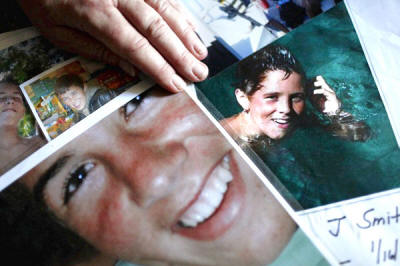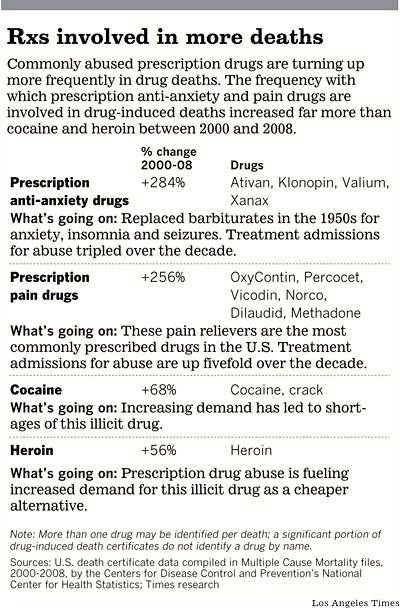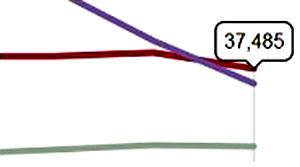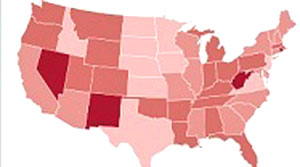|

by Lisa Girion, Scott Glover
and Doug Smith
September 17, 2011
from
LosAngelesTimes Website
|
Fueling the surge are
prescription pain and anxiety drugs that are potent,
highly addictive and especially dangerous when combined
with one another or with other drugs or alcohol. |
Propelled by an increase in prescription
narcotic overdoses, drug deaths now outnumber traffic fatalities in
the United States, a Times analysis of government data has found.
Drugs exceeded motor vehicle accidents as a cause of death in 2009,
killing at least 37,485 people nationwide, according to preliminary
data from the U.S. Centers for Disease Control and Prevention
(CDC).
While most major causes of preventable death are declining, drugs
are an exception. The death toll has doubled in the last decade, now
claiming a life every 14 minutes. By contrast, traffic accidents
have been dropping for decades because of huge investments in auto
safety.
Public health experts have used the comparison to draw attention to
the nation's growing prescription drug problem, which they
characterize as an epidemic. This is the first time that drugs have
accounted for more fatalities than traffic accidents since the
government started tracking drug-induced deaths in 1979.
Fueling the surge in deaths are prescription pain and anxiety drugs
that are potent, highly addictive and especially dangerous when
combined with one another or with other drugs or alcohol.
Among the most commonly abused are,
One relative newcomer to the scene is
Fentanyl, a painkiller that comes
in the form of patches and lollipops and is 100 times more powerful
than morphine.
Such drugs now cause more deaths than heroin and cocaine
combined.
"The problem is right here under our
noses in our medicine cabinets," said Laz Salinas, a sheriff's
commander in Santa Barbara, which has seen a dramatic rise in
prescription drug deaths in recent years.
Overdose victims range in age and
circumstance from teenagers who pop pills to get a heroin-like high
to middle-aged working men and women who take medications prescribed
for strained backs and bum knees and become addicted.
A review of hundreds of autopsy reports in Southern California
reveals one tragic demise after another:
-
A 19-year-old Army recruit, who
had just passed his military physical, took a handful of
Xanax and painkillers while partying with friends
-
A groom, anxious over his
upcoming wedding, overdosed on a cocktail of prescription
drugs
-
A teenage honors student
overdosed on painkillers her father left in his medicine
cabinet from a surgery years earlier
-
A toddler was orphaned after
both parents overdosed on prescription drugs months apart
-
A grandmother suffering from
chronic back pain apparently forgot she'd already taken her
daily regimen of pills and ended up double dosing
Many died after failed attempts at rehab
- or after using one too many times while contemplating quitting.
That's apparently what happened to a San
Diego woman found dead with a Fentanyl patch on her body, one of
five she'd applied in the 24 hours before her death. Next to her on
the couch was a notebook with information about rehab.
The seeds of the problem were planted more than a decade ago by
well-meaning efforts by doctors to mitigate suffering, as well as
aggressive sales campaigns by pharmaceutical manufacturers. In
hindsight, the liberalized prescription of pain drugs,
"may in fact be the cause of the
epidemic we're now facing," said Linda Rosenstock, dean of the
UCLA School of Public Health.
In some ways, prescription drugs are
more dangerous than illicit ones because users don't have their
guard up, said Los Angeles County Sheriff's Sgt. Steve Opferman,
head of a county task force on prescription drug-related crimes.
"People feel they are safer with
prescription drugs because you get them from a pharmacy and they
are prescribed by a doctor," Opferman said. "Younger people
believe they are safer because they see their parents taking
them. It doesn't have the same stigma as using street
narcotics."

Lori Smith of Aliso
Viejo with photographs of her son Nolan,
who died of a drug
overdose in January 2009, six months shy of his 16th birthday.
A toxicology test
turned up Zoloft, which had been prescribed for anxiety,
and a host of other
drugs that had not been prescribed,
including two
additional anti-anxiety drugs,
as well as morphine
and marijuana.
(Liz O. Baylen / Los
Angeles Times / September 18, 2011)
Lori Smith
said she believes that's what her son might have been thinking the
night he died six months shy of his 16th birthday.
Nolan Smith, of Aliso Viejo, loved to
surf, sail and fish with his brother and father. He suffered from
migraines and anxiety but showed no signs of drug abuse, his mother
said.
The night before he died in January 2009, Nolan called his mother at
work, asking for a ride to the girls basketball game at Aliso Niguel
High School. Lori told him she couldn't get away.
When Nolan didn't come home that evening, his parents called police
and his friends. His body was found the next morning on a stranger's
front porch.
A toxicology test turned up
Zoloft, which had been prescribed
for anxiety, and a host of other drugs that had not been prescribed,
including two additional anti-anxiety drugs, as well as morphine and
marijuana.
All investigators could give the family were theories.
"They said they will have parties
where the kids will throw a bunch of pills in a bowl and the
kids take them without knowing what they are," Lori said. "We
called all of his friends, but no one would say they were with
him. But he must have been with someone. You just don't do that
by yourself."
The triumph of public health policies
that have improved traffic safety over the years through the use of
seat belts, air bags and other measures stands in stark contrast to
the nation's record on prescription drugs.
Even though more people are driving more
miles, traffic fatalities have dropped by more than a third since
the early 1970s to 36,284 in 2009.
Drug-induced deaths had equaled or
surpassed traffic fatalities in California, 22 other states and the
District of Columbia even before the 2009 figures revealed the shift
at the national level, according to the Times analysis.
The Centers for Disease Control (CDC)
collects data on all causes of death each year and analyzes them to
identify health problems. Drug-induced deaths are mostly accidental
overdoses but also include suicides and fatal diseases caused by
drugs.
The CDC's 2009 statistics are the agency's most current. They are
considered preliminary because they reflect 96% of death
certificates filed. The remaining are deaths for which the causes
were not immediately clear.
Drug fatalities more than doubled among teens and young adults
between 2000 and 2008, years for which more detailed data are
available. Deaths more than tripled among people aged 50 to 69, the
Times analysis found. In terms of sheer numbers, the death toll is
highest among people in their 40s.
Overdose deaths involving prescription painkillers, including
OxyContin and Vicodin, and anti-anxiety drugs such as Valium and
Xanax more than tripled between 2000 and 2008.
Comparison of drugs frequently involved in deaths

The rise in deaths corresponds with
doctors prescribing more
painkillers and anti-anxiety medications.
The number of prescriptions for the
strongest pain pills filled at California pharmacies, for instance,
increased more than 43% since 2007 - and the doses grew by even
more, nearly 50%, according to a review of prescribing data
collected by the state.
Those prescriptions provide relief to pain sufferers but also fuel a
thriving black market.
Prescription drugs are traded on
Internet chat rooms that buzz with offers of "vikes," "percs" and "oxys"
for $10 to $80 a pill. They are sold on street corners along with
heroin, marijuana and crack. An addiction to prescription drugs can
be costly; a heavy OxyContin habit can run twice as much as a heroin
addiction, authorities say.
On a recent weekday morning, Los Angeles County undercover sheriff's
deputies posing as drug buyers easily purchased enough pills to fill
a medicine cabinet on a sidewalk a few blocks south of Los Angeles
City Hall.
The most commonly abused prescription drug,
hydrocodone, also is the most
widely prescribed drug in America, according to the U.S. Drug
Enforcement Agency (DEA).
Better known as
Vicodin, the pain reliever is
prescribed more often than the top cholesterol drug and the top
antibiotic.
"We have an insatiable appetite for
this drug - insatiable," Joseph T. Rannazzisi, a top DEA
administrator, told a group of pharmacists at a regulatory
meeting in Sacramento.
In April, the White House Office of
National Drug Control Policy announced initiatives aimed at
stanching prescription drug abuse.
The plans include a series of drug
take-back days, modeled after similar programs involving weapons, in
which consumers are encouraged to turn leftover prescription drugs
in to authorities. Another initiative would develop voluntary
courses to train physicians on how to safely prescribe pain drugs, a
curriculum that is not widely taught in medical schools.
Initial attempts to reverse the trend in drug deaths - such as
state-run prescription drug-monitoring programs aimed at thwarting
"doctor-shopping" addicts - don't appear to be having much effect,
experts say.
"What's really scary is we don't
know a lot about how to reduce prescription deaths," said Amy
S.B. Bohnert, a researcher at the University of Michigan Medical
School who is studying ways to lower the risk of prescription
drugs.
"It's a wonderful medical advancement that we can treat pain,"
Bohnert said. "But we haven't figured out the safety belt yet."
|
 |
 |
|
Interactive
- Deaths from drugs, motor vehicles and firearms |
Interactive
map - Rise in drug-induced deaths since 2000 |
|




